Financial Accounting Issues Report: Wesfarmers Company Analysis
VerifiedAdded on 2023/01/13
|9
|1974
|43
Report
AI Summary
This report provides a comprehensive analysis of financial accounting issues, focusing on the recognition and reporting of asset values. It examines the application of historical cost and fair value methods, using the Wesfarmers company as a case study. The report delves into revenue recognition, expense classification, and the valuation of assets such as receivables, property, plant, and equipment, and goodwill. It also addresses interest-bearing loans and borrowings. The analysis aligns with accounting standards and policies, providing a detailed examination of the company's financial statements. The findings highlight the importance of accurate asset classification and the use of fair value accounting. The report concludes with recommendations for improved accounting practices, emphasizing the need for transparency and adherence to accounting standards to reflect the true economic value and financial position of the company. The report also underscores the importance of clear disclosure in the footnotes to the financial statements.
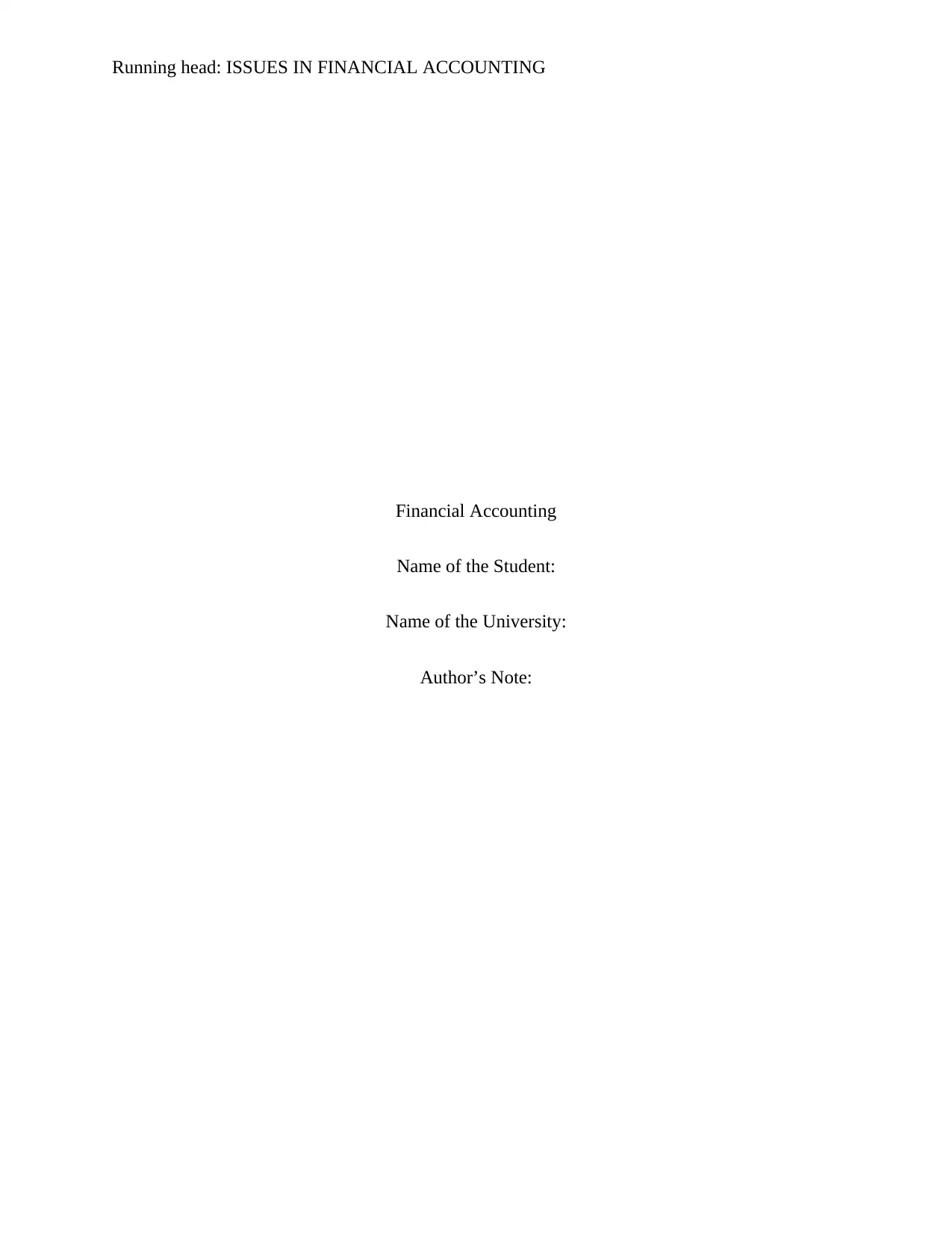
Running head: ISSUES IN FINANCIAL ACCOUNTING
Financial Accounting
Name of the Student:
Name of the University:
Author’s Note:
Financial Accounting
Name of the Student:
Name of the University:
Author’s Note:
Paraphrase This Document
Need a fresh take? Get an instant paraphrase of this document with our AI Paraphraser
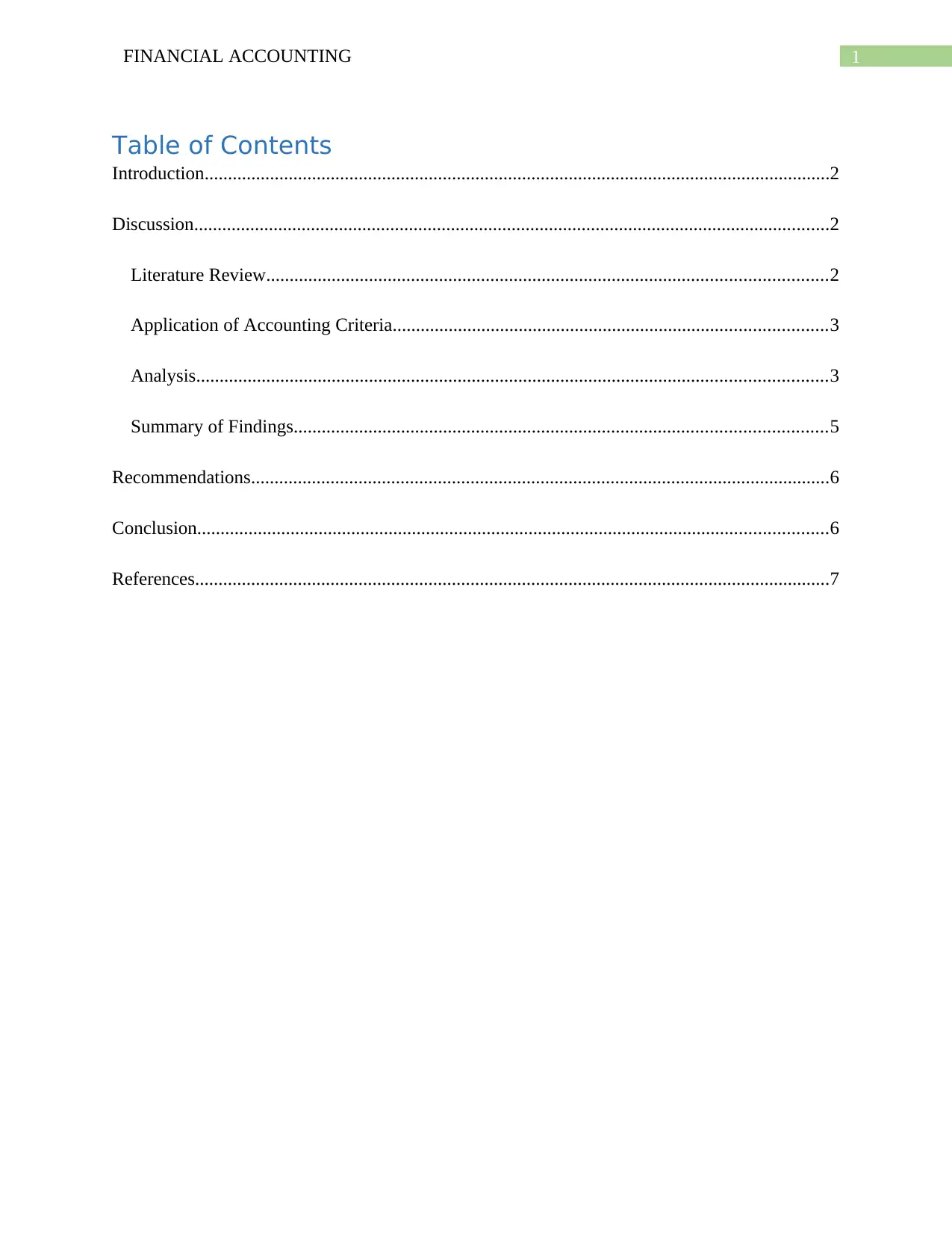
1FINANCIAL ACCOUNTING
Table of Contents
Introduction......................................................................................................................................2
Discussion........................................................................................................................................2
Literature Review........................................................................................................................2
Application of Accounting Criteria.............................................................................................3
Analysis.......................................................................................................................................3
Summary of Findings..................................................................................................................5
Recommendations............................................................................................................................6
Conclusion.......................................................................................................................................6
References........................................................................................................................................7
Table of Contents
Introduction......................................................................................................................................2
Discussion........................................................................................................................................2
Literature Review........................................................................................................................2
Application of Accounting Criteria.............................................................................................3
Analysis.......................................................................................................................................3
Summary of Findings..................................................................................................................5
Recommendations............................................................................................................................6
Conclusion.......................................................................................................................................6
References........................................................................................................................................7
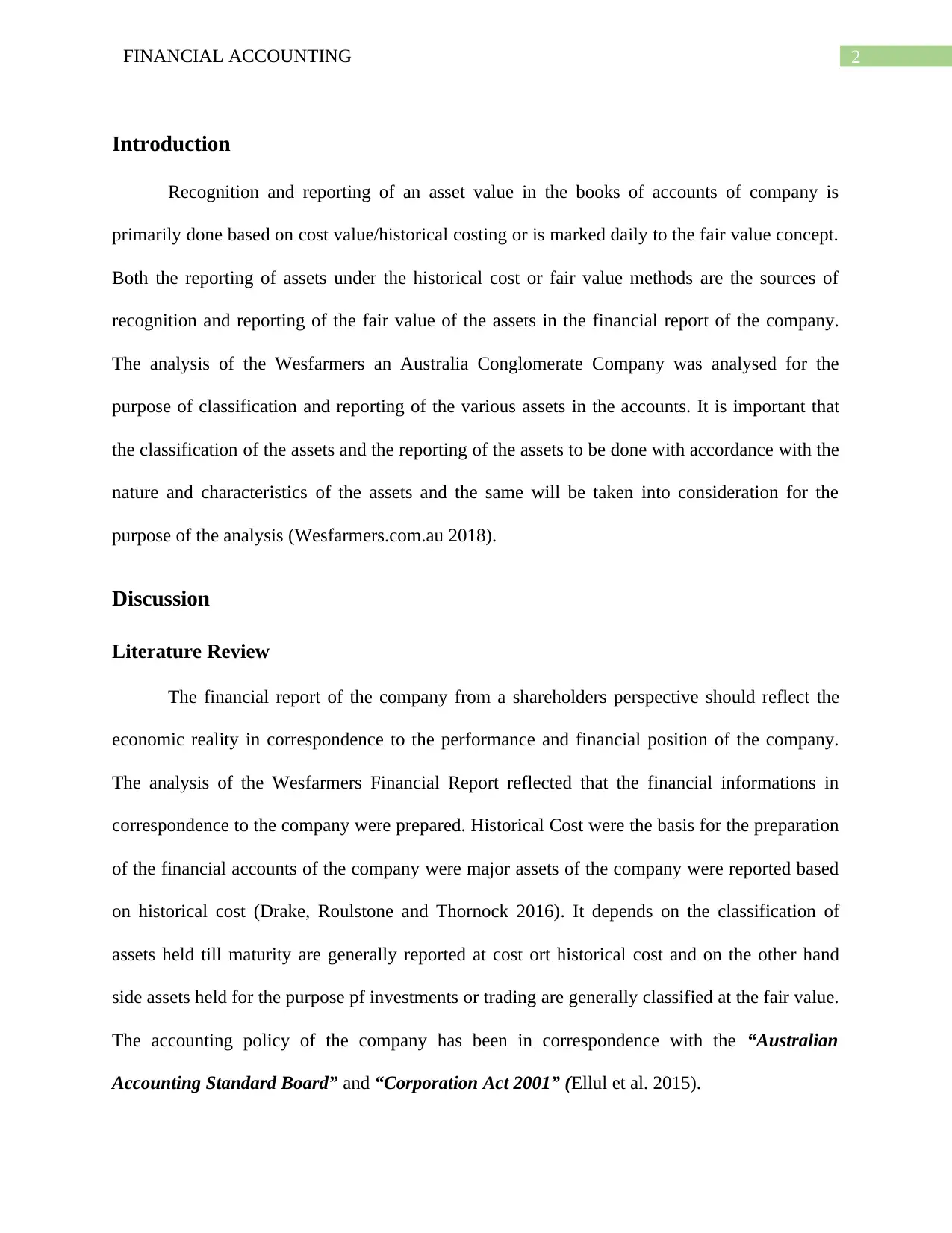
2FINANCIAL ACCOUNTING
Introduction
Recognition and reporting of an asset value in the books of accounts of company is
primarily done based on cost value/historical costing or is marked daily to the fair value concept.
Both the reporting of assets under the historical cost or fair value methods are the sources of
recognition and reporting of the fair value of the assets in the financial report of the company.
The analysis of the Wesfarmers an Australia Conglomerate Company was analysed for the
purpose of classification and reporting of the various assets in the accounts. It is important that
the classification of the assets and the reporting of the assets to be done with accordance with the
nature and characteristics of the assets and the same will be taken into consideration for the
purpose of the analysis (Wesfarmers.com.au 2018).
Discussion
Literature Review
The financial report of the company from a shareholders perspective should reflect the
economic reality in correspondence to the performance and financial position of the company.
The analysis of the Wesfarmers Financial Report reflected that the financial informations in
correspondence to the company were prepared. Historical Cost were the basis for the preparation
of the financial accounts of the company were major assets of the company were reported based
on historical cost (Drake, Roulstone and Thornock 2016). It depends on the classification of
assets held till maturity are generally reported at cost ort historical cost and on the other hand
side assets held for the purpose pf investments or trading are generally classified at the fair value.
The accounting policy of the company has been in correspondence with the “Australian
Accounting Standard Board” and “Corporation Act 2001” (Ellul et al. 2015).
Introduction
Recognition and reporting of an asset value in the books of accounts of company is
primarily done based on cost value/historical costing or is marked daily to the fair value concept.
Both the reporting of assets under the historical cost or fair value methods are the sources of
recognition and reporting of the fair value of the assets in the financial report of the company.
The analysis of the Wesfarmers an Australia Conglomerate Company was analysed for the
purpose of classification and reporting of the various assets in the accounts. It is important that
the classification of the assets and the reporting of the assets to be done with accordance with the
nature and characteristics of the assets and the same will be taken into consideration for the
purpose of the analysis (Wesfarmers.com.au 2018).
Discussion
Literature Review
The financial report of the company from a shareholders perspective should reflect the
economic reality in correspondence to the performance and financial position of the company.
The analysis of the Wesfarmers Financial Report reflected that the financial informations in
correspondence to the company were prepared. Historical Cost were the basis for the preparation
of the financial accounts of the company were major assets of the company were reported based
on historical cost (Drake, Roulstone and Thornock 2016). It depends on the classification of
assets held till maturity are generally reported at cost ort historical cost and on the other hand
side assets held for the purpose pf investments or trading are generally classified at the fair value.
The accounting policy of the company has been in correspondence with the “Australian
Accounting Standard Board” and “Corporation Act 2001” (Ellul et al. 2015).
⊘ This is a preview!⊘
Do you want full access?
Subscribe today to unlock all pages.

Trusted by 1+ million students worldwide
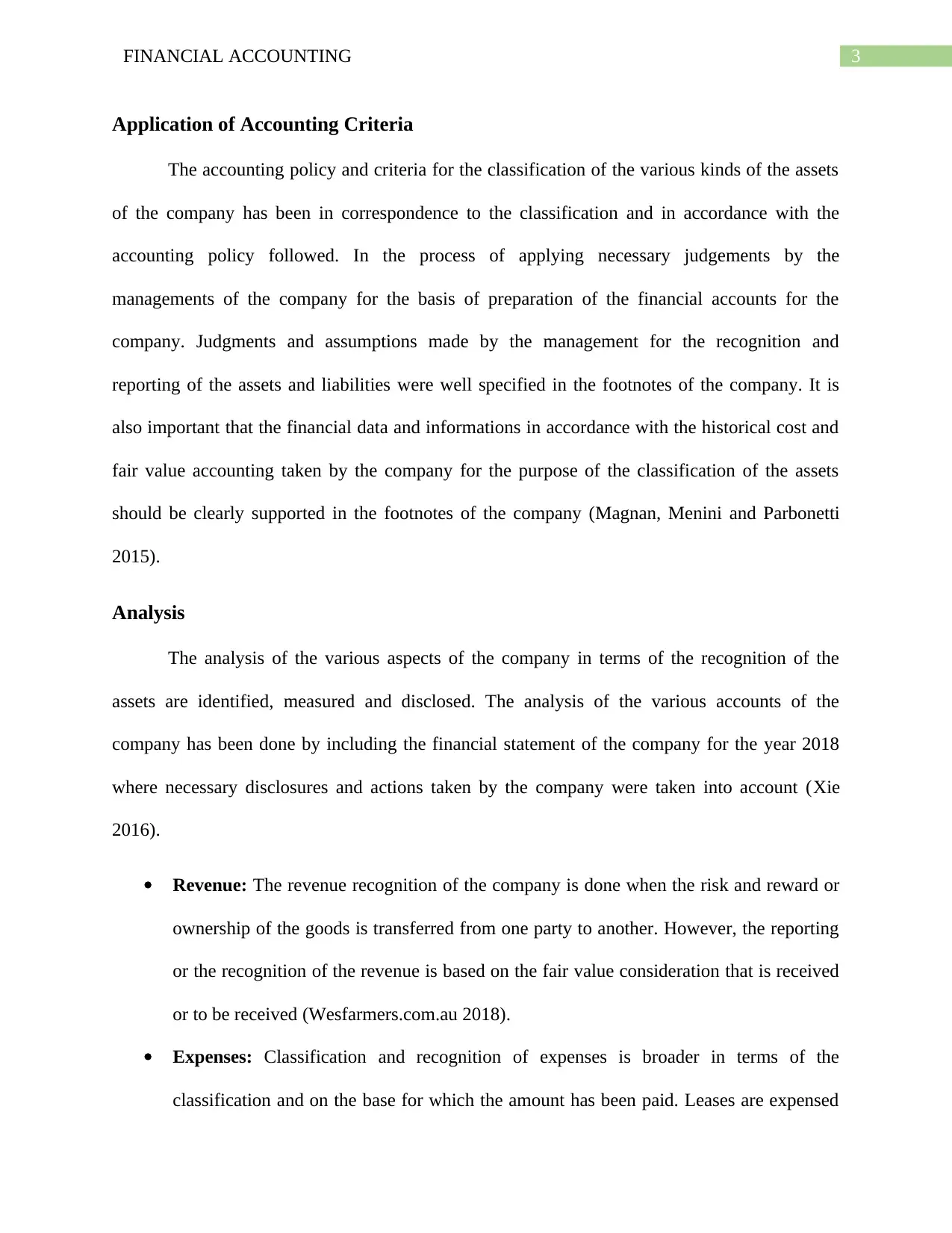
3FINANCIAL ACCOUNTING
Application of Accounting Criteria
The accounting policy and criteria for the classification of the various kinds of the assets
of the company has been in correspondence to the classification and in accordance with the
accounting policy followed. In the process of applying necessary judgements by the
managements of the company for the basis of preparation of the financial accounts for the
company. Judgments and assumptions made by the management for the recognition and
reporting of the assets and liabilities were well specified in the footnotes of the company. It is
also important that the financial data and informations in accordance with the historical cost and
fair value accounting taken by the company for the purpose of the classification of the assets
should be clearly supported in the footnotes of the company (Magnan, Menini and Parbonetti
2015).
Analysis
The analysis of the various aspects of the company in terms of the recognition of the
assets are identified, measured and disclosed. The analysis of the various accounts of the
company has been done by including the financial statement of the company for the year 2018
where necessary disclosures and actions taken by the company were taken into account (Xie
2016).
Revenue: The revenue recognition of the company is done when the risk and reward or
ownership of the goods is transferred from one party to another. However, the reporting
or the recognition of the revenue is based on the fair value consideration that is received
or to be received (Wesfarmers.com.au 2018).
Expenses: Classification and recognition of expenses is broader in terms of the
classification and on the base for which the amount has been paid. Leases are expensed
Application of Accounting Criteria
The accounting policy and criteria for the classification of the various kinds of the assets
of the company has been in correspondence to the classification and in accordance with the
accounting policy followed. In the process of applying necessary judgements by the
managements of the company for the basis of preparation of the financial accounts for the
company. Judgments and assumptions made by the management for the recognition and
reporting of the assets and liabilities were well specified in the footnotes of the company. It is
also important that the financial data and informations in accordance with the historical cost and
fair value accounting taken by the company for the purpose of the classification of the assets
should be clearly supported in the footnotes of the company (Magnan, Menini and Parbonetti
2015).
Analysis
The analysis of the various aspects of the company in terms of the recognition of the
assets are identified, measured and disclosed. The analysis of the various accounts of the
company has been done by including the financial statement of the company for the year 2018
where necessary disclosures and actions taken by the company were taken into account (Xie
2016).
Revenue: The revenue recognition of the company is done when the risk and reward or
ownership of the goods is transferred from one party to another. However, the reporting
or the recognition of the revenue is based on the fair value consideration that is received
or to be received (Wesfarmers.com.au 2018).
Expenses: Classification and recognition of expenses is broader in terms of the
classification and on the base for which the amount has been paid. Leases are expensed
Paraphrase This Document
Need a fresh take? Get an instant paraphrase of this document with our AI Paraphraser
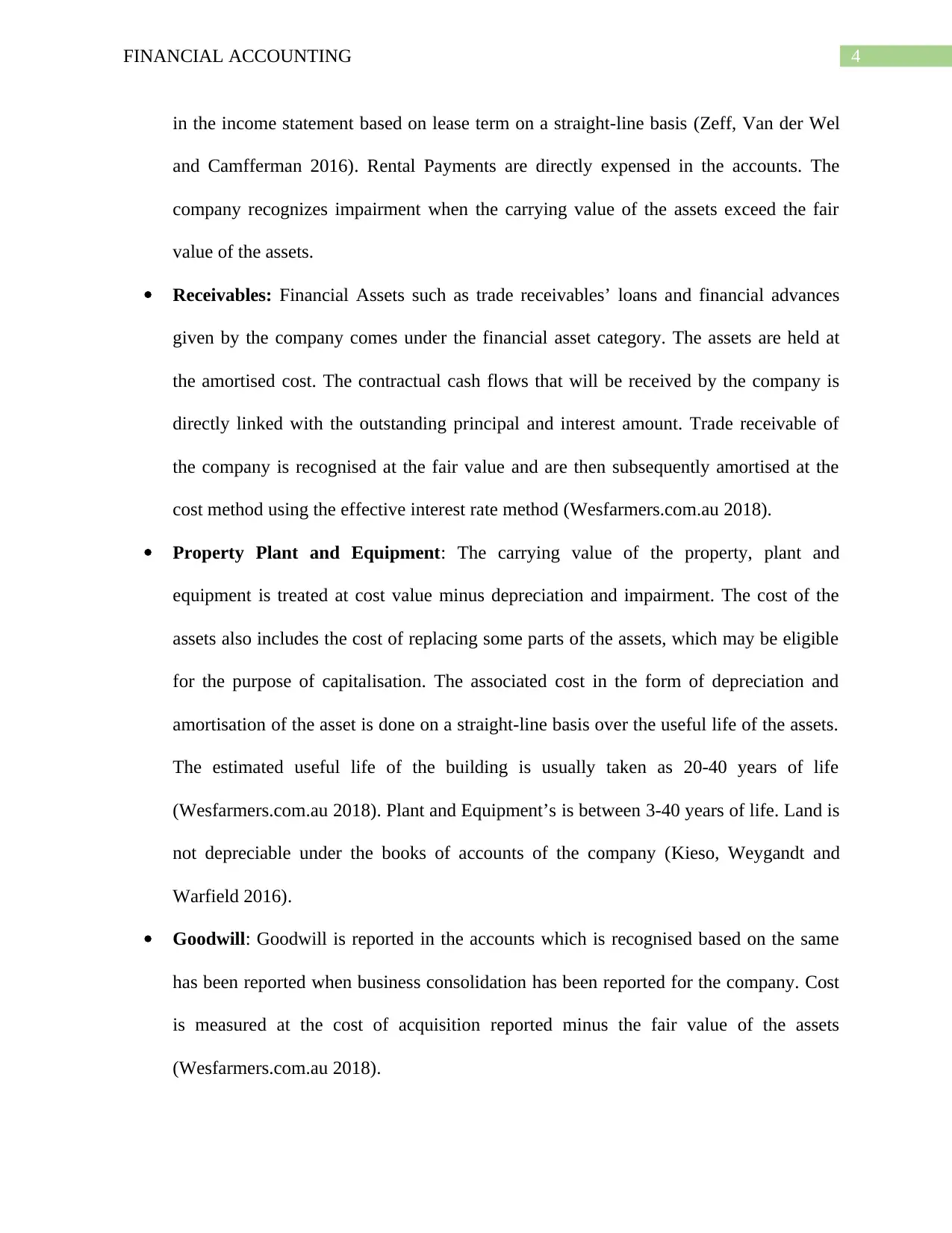
4FINANCIAL ACCOUNTING
in the income statement based on lease term on a straight-line basis (Zeff, Van der Wel
and Camfferman 2016). Rental Payments are directly expensed in the accounts. The
company recognizes impairment when the carrying value of the assets exceed the fair
value of the assets.
Receivables: Financial Assets such as trade receivables’ loans and financial advances
given by the company comes under the financial asset category. The assets are held at
the amortised cost. The contractual cash flows that will be received by the company is
directly linked with the outstanding principal and interest amount. Trade receivable of
the company is recognised at the fair value and are then subsequently amortised at the
cost method using the effective interest rate method (Wesfarmers.com.au 2018).
Property Plant and Equipment: The carrying value of the property, plant and
equipment is treated at cost value minus depreciation and impairment. The cost of the
assets also includes the cost of replacing some parts of the assets, which may be eligible
for the purpose of capitalisation. The associated cost in the form of depreciation and
amortisation of the asset is done on a straight-line basis over the useful life of the assets.
The estimated useful life of the building is usually taken as 20-40 years of life
(Wesfarmers.com.au 2018). Plant and Equipment’s is between 3-40 years of life. Land is
not depreciable under the books of accounts of the company (Kieso, Weygandt and
Warfield 2016).
Goodwill: Goodwill is reported in the accounts which is recognised based on the same
has been reported when business consolidation has been reported for the company. Cost
is measured at the cost of acquisition reported minus the fair value of the assets
(Wesfarmers.com.au 2018).
in the income statement based on lease term on a straight-line basis (Zeff, Van der Wel
and Camfferman 2016). Rental Payments are directly expensed in the accounts. The
company recognizes impairment when the carrying value of the assets exceed the fair
value of the assets.
Receivables: Financial Assets such as trade receivables’ loans and financial advances
given by the company comes under the financial asset category. The assets are held at
the amortised cost. The contractual cash flows that will be received by the company is
directly linked with the outstanding principal and interest amount. Trade receivable of
the company is recognised at the fair value and are then subsequently amortised at the
cost method using the effective interest rate method (Wesfarmers.com.au 2018).
Property Plant and Equipment: The carrying value of the property, plant and
equipment is treated at cost value minus depreciation and impairment. The cost of the
assets also includes the cost of replacing some parts of the assets, which may be eligible
for the purpose of capitalisation. The associated cost in the form of depreciation and
amortisation of the asset is done on a straight-line basis over the useful life of the assets.
The estimated useful life of the building is usually taken as 20-40 years of life
(Wesfarmers.com.au 2018). Plant and Equipment’s is between 3-40 years of life. Land is
not depreciable under the books of accounts of the company (Kieso, Weygandt and
Warfield 2016).
Goodwill: Goodwill is reported in the accounts which is recognised based on the same
has been reported when business consolidation has been reported for the company. Cost
is measured at the cost of acquisition reported minus the fair value of the assets
(Wesfarmers.com.au 2018).
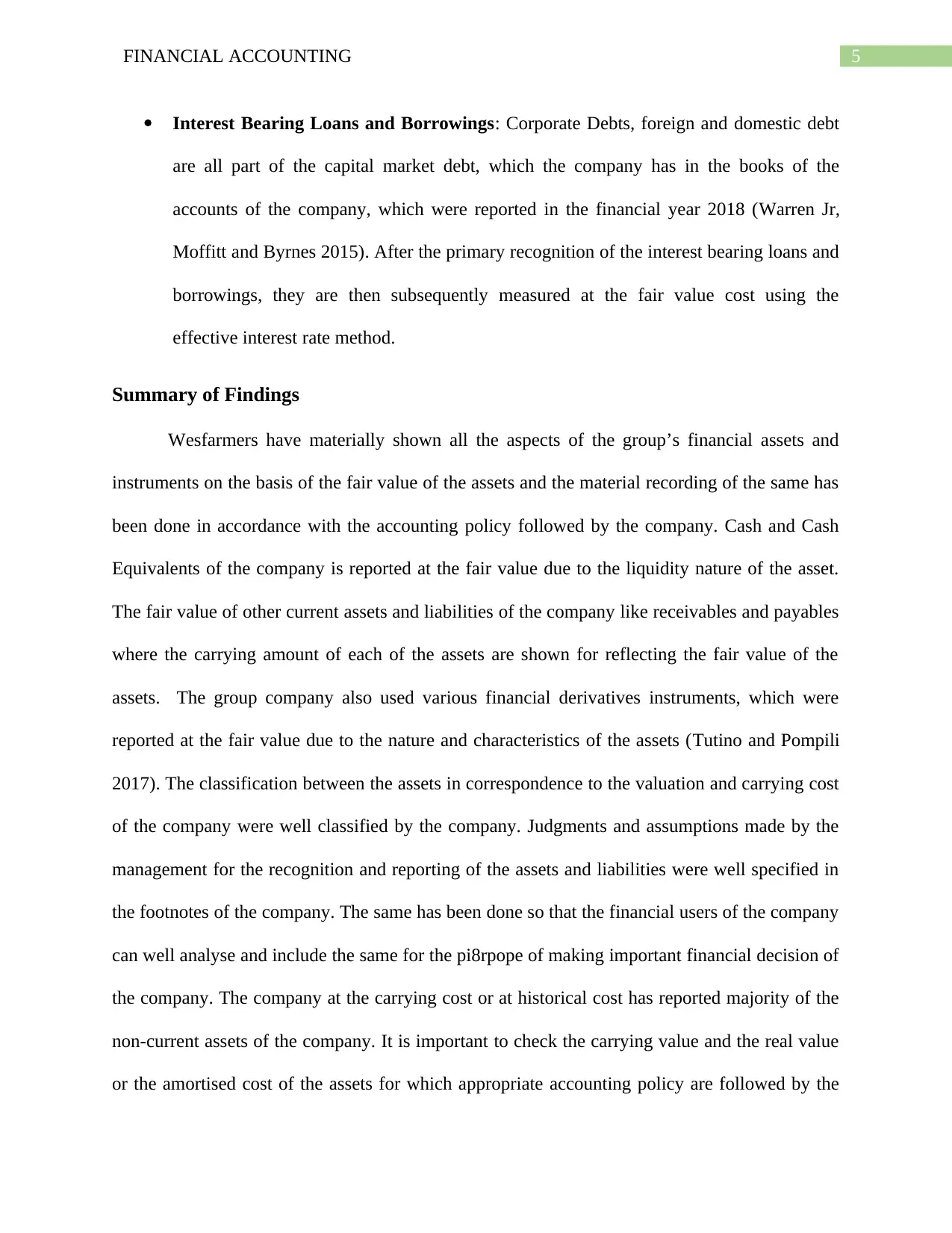
5FINANCIAL ACCOUNTING
Interest Bearing Loans and Borrowings: Corporate Debts, foreign and domestic debt
are all part of the capital market debt, which the company has in the books of the
accounts of the company, which were reported in the financial year 2018 (Warren Jr,
Moffitt and Byrnes 2015). After the primary recognition of the interest bearing loans and
borrowings, they are then subsequently measured at the fair value cost using the
effective interest rate method.
Summary of Findings
Wesfarmers have materially shown all the aspects of the group’s financial assets and
instruments on the basis of the fair value of the assets and the material recording of the same has
been done in accordance with the accounting policy followed by the company. Cash and Cash
Equivalents of the company is reported at the fair value due to the liquidity nature of the asset.
The fair value of other current assets and liabilities of the company like receivables and payables
where the carrying amount of each of the assets are shown for reflecting the fair value of the
assets. The group company also used various financial derivatives instruments, which were
reported at the fair value due to the nature and characteristics of the assets (Tutino and Pompili
2017). The classification between the assets in correspondence to the valuation and carrying cost
of the company were well classified by the company. Judgments and assumptions made by the
management for the recognition and reporting of the assets and liabilities were well specified in
the footnotes of the company. The same has been done so that the financial users of the company
can well analyse and include the same for the pi8rpope of making important financial decision of
the company. The company at the carrying cost or at historical cost has reported majority of the
non-current assets of the company. It is important to check the carrying value and the real value
or the amortised cost of the assets for which appropriate accounting policy are followed by the
Interest Bearing Loans and Borrowings: Corporate Debts, foreign and domestic debt
are all part of the capital market debt, which the company has in the books of the
accounts of the company, which were reported in the financial year 2018 (Warren Jr,
Moffitt and Byrnes 2015). After the primary recognition of the interest bearing loans and
borrowings, they are then subsequently measured at the fair value cost using the
effective interest rate method.
Summary of Findings
Wesfarmers have materially shown all the aspects of the group’s financial assets and
instruments on the basis of the fair value of the assets and the material recording of the same has
been done in accordance with the accounting policy followed by the company. Cash and Cash
Equivalents of the company is reported at the fair value due to the liquidity nature of the asset.
The fair value of other current assets and liabilities of the company like receivables and payables
where the carrying amount of each of the assets are shown for reflecting the fair value of the
assets. The group company also used various financial derivatives instruments, which were
reported at the fair value due to the nature and characteristics of the assets (Tutino and Pompili
2017). The classification between the assets in correspondence to the valuation and carrying cost
of the company were well classified by the company. Judgments and assumptions made by the
management for the recognition and reporting of the assets and liabilities were well specified in
the footnotes of the company. The same has been done so that the financial users of the company
can well analyse and include the same for the pi8rpope of making important financial decision of
the company. The company at the carrying cost or at historical cost has reported majority of the
non-current assets of the company. It is important to check the carrying value and the real value
or the amortised cost of the assets for which appropriate accounting policy are followed by the
⊘ This is a preview!⊘
Do you want full access?
Subscribe today to unlock all pages.

Trusted by 1+ million students worldwide
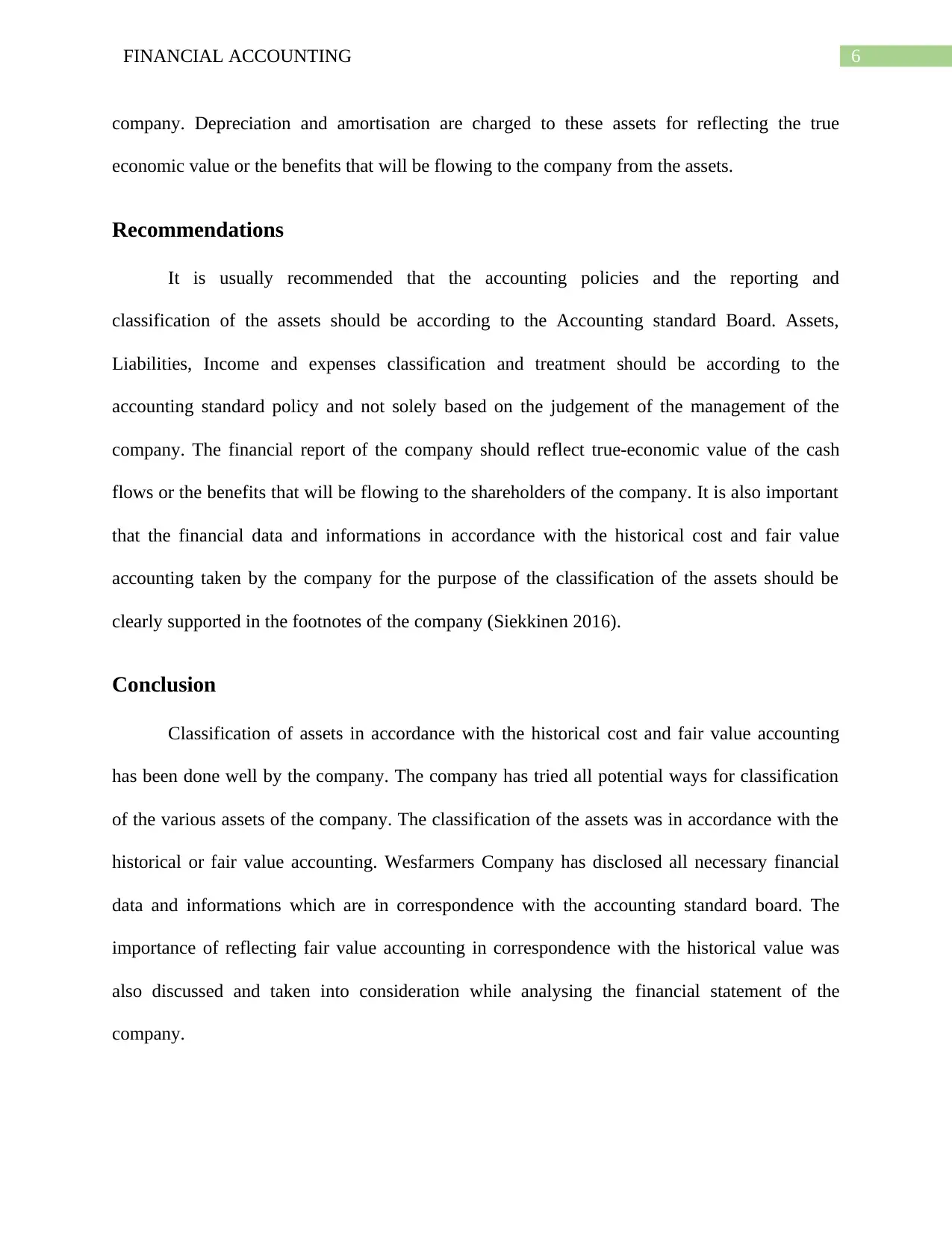
6FINANCIAL ACCOUNTING
company. Depreciation and amortisation are charged to these assets for reflecting the true
economic value or the benefits that will be flowing to the company from the assets.
Recommendations
It is usually recommended that the accounting policies and the reporting and
classification of the assets should be according to the Accounting standard Board. Assets,
Liabilities, Income and expenses classification and treatment should be according to the
accounting standard policy and not solely based on the judgement of the management of the
company. The financial report of the company should reflect true-economic value of the cash
flows or the benefits that will be flowing to the shareholders of the company. It is also important
that the financial data and informations in accordance with the historical cost and fair value
accounting taken by the company for the purpose of the classification of the assets should be
clearly supported in the footnotes of the company (Siekkinen 2016).
Conclusion
Classification of assets in accordance with the historical cost and fair value accounting
has been done well by the company. The company has tried all potential ways for classification
of the various assets of the company. The classification of the assets was in accordance with the
historical or fair value accounting. Wesfarmers Company has disclosed all necessary financial
data and informations which are in correspondence with the accounting standard board. The
importance of reflecting fair value accounting in correspondence with the historical value was
also discussed and taken into consideration while analysing the financial statement of the
company.
company. Depreciation and amortisation are charged to these assets for reflecting the true
economic value or the benefits that will be flowing to the company from the assets.
Recommendations
It is usually recommended that the accounting policies and the reporting and
classification of the assets should be according to the Accounting standard Board. Assets,
Liabilities, Income and expenses classification and treatment should be according to the
accounting standard policy and not solely based on the judgement of the management of the
company. The financial report of the company should reflect true-economic value of the cash
flows or the benefits that will be flowing to the shareholders of the company. It is also important
that the financial data and informations in accordance with the historical cost and fair value
accounting taken by the company for the purpose of the classification of the assets should be
clearly supported in the footnotes of the company (Siekkinen 2016).
Conclusion
Classification of assets in accordance with the historical cost and fair value accounting
has been done well by the company. The company has tried all potential ways for classification
of the various assets of the company. The classification of the assets was in accordance with the
historical or fair value accounting. Wesfarmers Company has disclosed all necessary financial
data and informations which are in correspondence with the accounting standard board. The
importance of reflecting fair value accounting in correspondence with the historical value was
also discussed and taken into consideration while analysing the financial statement of the
company.
Paraphrase This Document
Need a fresh take? Get an instant paraphrase of this document with our AI Paraphraser
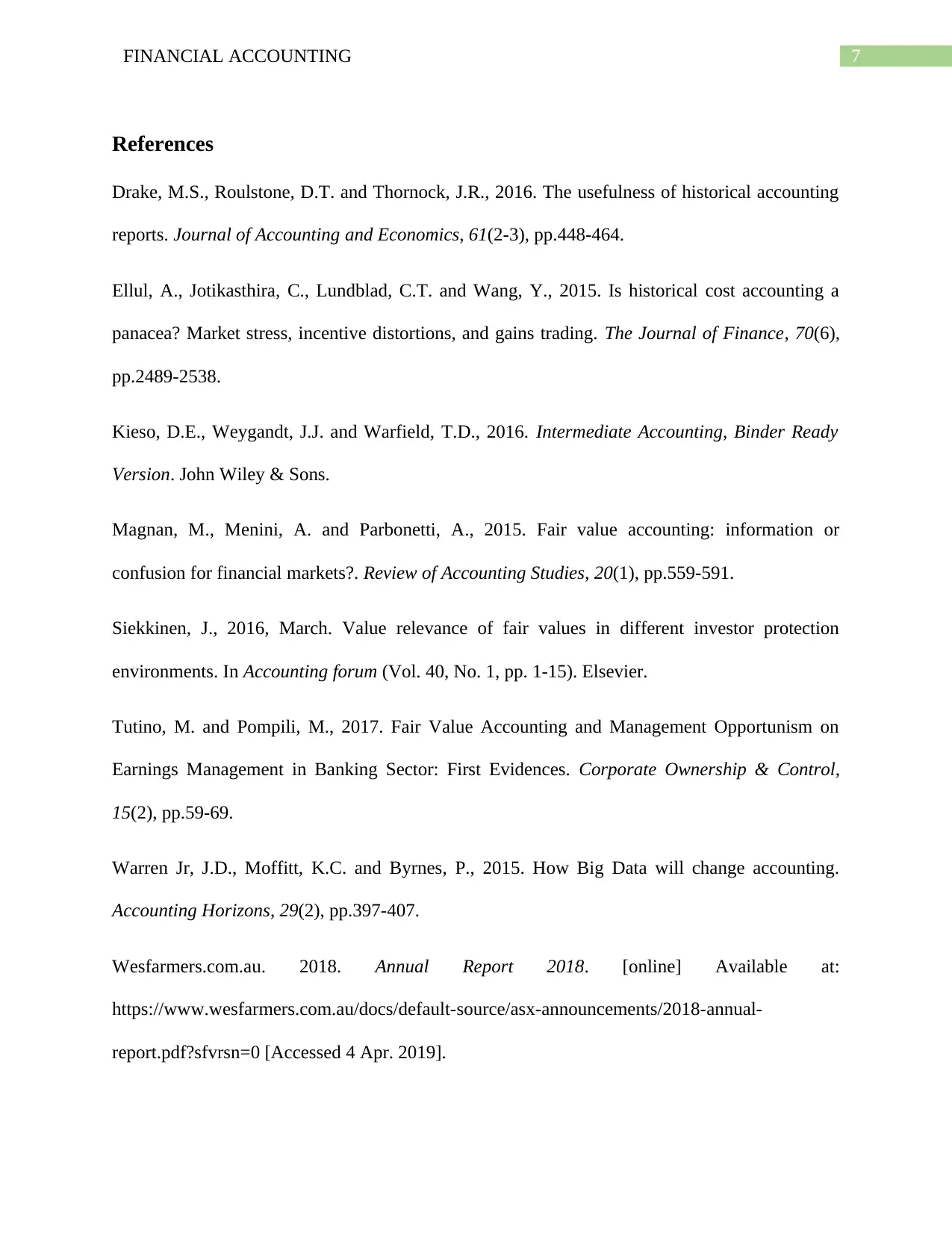
7FINANCIAL ACCOUNTING
References
Drake, M.S., Roulstone, D.T. and Thornock, J.R., 2016. The usefulness of historical accounting
reports. Journal of Accounting and Economics, 61(2-3), pp.448-464.
Ellul, A., Jotikasthira, C., Lundblad, C.T. and Wang, Y., 2015. Is historical cost accounting a
panacea? Market stress, incentive distortions, and gains trading. The Journal of Finance, 70(6),
pp.2489-2538.
Kieso, D.E., Weygandt, J.J. and Warfield, T.D., 2016. Intermediate Accounting, Binder Ready
Version. John Wiley & Sons.
Magnan, M., Menini, A. and Parbonetti, A., 2015. Fair value accounting: information or
confusion for financial markets?. Review of Accounting Studies, 20(1), pp.559-591.
Siekkinen, J., 2016, March. Value relevance of fair values in different investor protection
environments. In Accounting forum (Vol. 40, No. 1, pp. 1-15). Elsevier.
Tutino, M. and Pompili, M., 2017. Fair Value Accounting and Management Opportunism on
Earnings Management in Banking Sector: First Evidences. Corporate Ownership & Control,
15(2), pp.59-69.
Warren Jr, J.D., Moffitt, K.C. and Byrnes, P., 2015. How Big Data will change accounting.
Accounting Horizons, 29(2), pp.397-407.
Wesfarmers.com.au. 2018. Annual Report 2018. [online] Available at:
https://www.wesfarmers.com.au/docs/default-source/asx-announcements/2018-annual-
report.pdf?sfvrsn=0 [Accessed 4 Apr. 2019].
References
Drake, M.S., Roulstone, D.T. and Thornock, J.R., 2016. The usefulness of historical accounting
reports. Journal of Accounting and Economics, 61(2-3), pp.448-464.
Ellul, A., Jotikasthira, C., Lundblad, C.T. and Wang, Y., 2015. Is historical cost accounting a
panacea? Market stress, incentive distortions, and gains trading. The Journal of Finance, 70(6),
pp.2489-2538.
Kieso, D.E., Weygandt, J.J. and Warfield, T.D., 2016. Intermediate Accounting, Binder Ready
Version. John Wiley & Sons.
Magnan, M., Menini, A. and Parbonetti, A., 2015. Fair value accounting: information or
confusion for financial markets?. Review of Accounting Studies, 20(1), pp.559-591.
Siekkinen, J., 2016, March. Value relevance of fair values in different investor protection
environments. In Accounting forum (Vol. 40, No. 1, pp. 1-15). Elsevier.
Tutino, M. and Pompili, M., 2017. Fair Value Accounting and Management Opportunism on
Earnings Management in Banking Sector: First Evidences. Corporate Ownership & Control,
15(2), pp.59-69.
Warren Jr, J.D., Moffitt, K.C. and Byrnes, P., 2015. How Big Data will change accounting.
Accounting Horizons, 29(2), pp.397-407.
Wesfarmers.com.au. 2018. Annual Report 2018. [online] Available at:
https://www.wesfarmers.com.au/docs/default-source/asx-announcements/2018-annual-
report.pdf?sfvrsn=0 [Accessed 4 Apr. 2019].
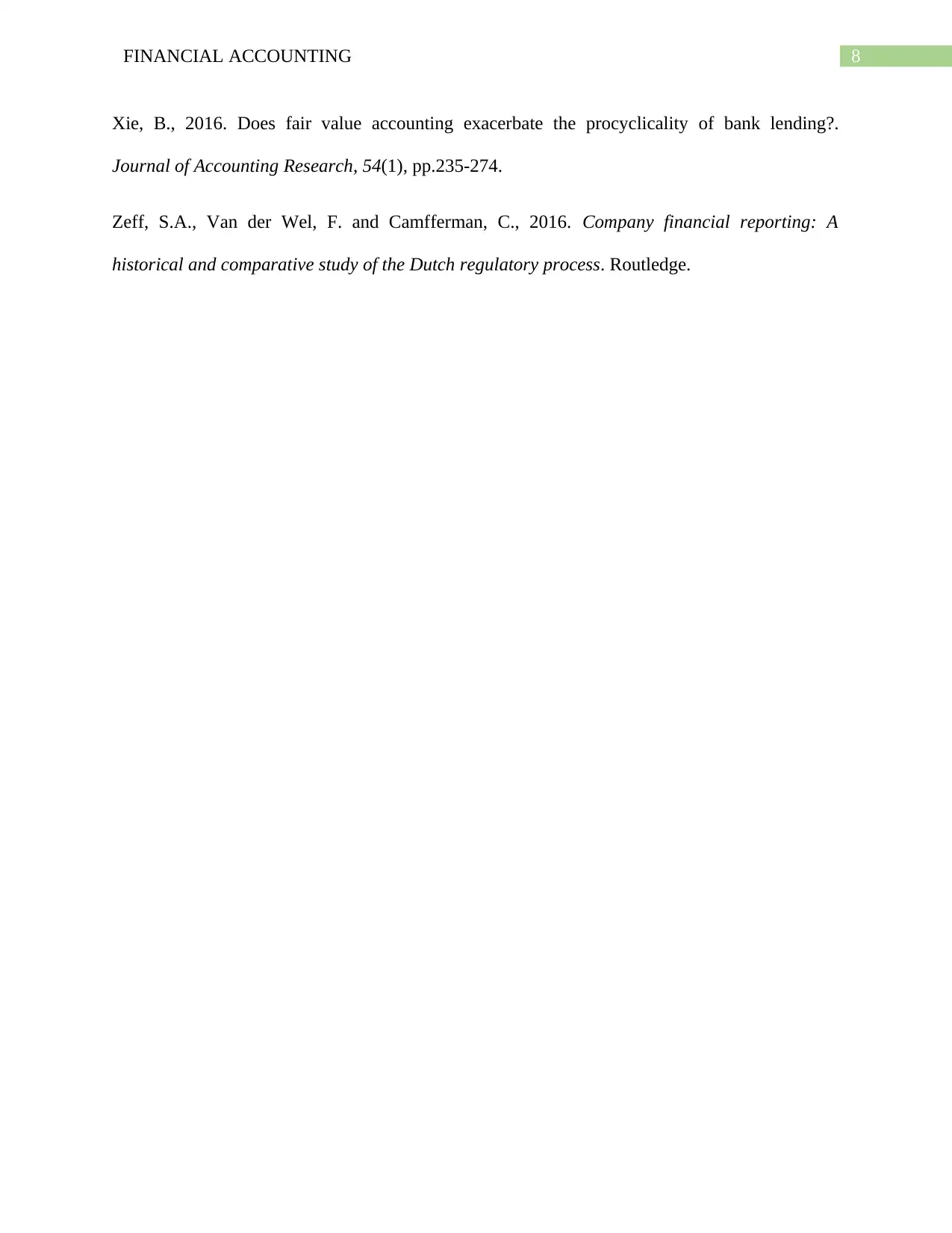
8FINANCIAL ACCOUNTING
Xie, B., 2016. Does fair value accounting exacerbate the procyclicality of bank lending?.
Journal of Accounting Research, 54(1), pp.235-274.
Zeff, S.A., Van der Wel, F. and Camfferman, C., 2016. Company financial reporting: A
historical and comparative study of the Dutch regulatory process. Routledge.
Xie, B., 2016. Does fair value accounting exacerbate the procyclicality of bank lending?.
Journal of Accounting Research, 54(1), pp.235-274.
Zeff, S.A., Van der Wel, F. and Camfferman, C., 2016. Company financial reporting: A
historical and comparative study of the Dutch regulatory process. Routledge.
⊘ This is a preview!⊘
Do you want full access?
Subscribe today to unlock all pages.

Trusted by 1+ million students worldwide
1 out of 9
Related Documents
Your All-in-One AI-Powered Toolkit for Academic Success.
+13062052269
info@desklib.com
Available 24*7 on WhatsApp / Email
![[object Object]](/_next/static/media/star-bottom.7253800d.svg)
Unlock your academic potential
Copyright © 2020–2025 A2Z Services. All Rights Reserved. Developed and managed by ZUCOL.




